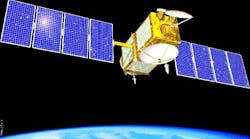Although it was designed to last only three to five years, the Jason-1 ocean altimetry satellite operated for 11 years before being decommissioned. Since its launch in December 2001, it orbited the Earth 53,500 times. The satellite collected data mapping sea level, wind speed, and wave height for more than 95% of Earth’s ice-free ocean every 10 days. In doing so, it enabled more accurate forecasting for weather, ocean, and climate changes. For example, it was instrumental in gaining information about changes in the Pacific Ocean, including the El Nino and La Nina events.
During some of its mission, Jason-1 flew in coordinated orbits with both its predecessor TOPEX/Poseidon and its successor, the Ocean Surface Topography Mission/Jason-2 (launched in 2008). These orbit periods, which each lasted about three years, cross-calibrated the satellites. In doing so, they enabled a 20-plus-year unbroken climate record of sea-level change while doubling data coverage.
Jason-1, which was a joint effort of NASA and the Centre National d’Etudes Spatiales (CNES), lost contact after its last transmitter failed. All attempts at re-establishing communications were ineffective. On July 1, controllers commanded Jason-1 into a safe hold state and turned off its magnetometer and reaction wheels. Without those attitude control systems, the satellite and its solar panels will slowly drift away from pointing at the sun and its batteries will discharge. It won’t re-enter Earth’s atmosphere for at least 1000 years.
The in-orbit Jason-2 mission is in good health and continues to collect science and operational data operated by the meteorological agencies of the US National Oceanic and Atmospheric Administration and Europe’s EUMETSAT in collaboration with NASA and CNES. The same US/European team is preparing to launch the next satellite in the series, Jason-3, in March 2015.
